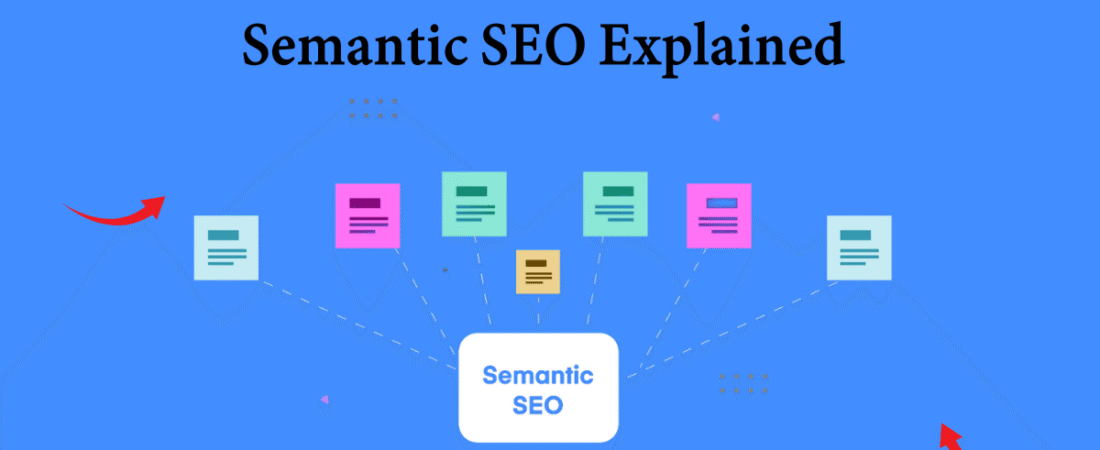Search Engine Optimization, or SEO, is the process of improving a website so that it appears higher in search results. For years, SEO was mainly about choosing the right keywords and adding them throughout your content. While keywords are still important, search engines like Google have become much smarter.
With updates such as Hummingbird, RankBrain, and BERT, Google now focuses on understanding the meaning behind search queries, not just the words used.
This shift has made semantic SEO a key strategy for businesses and content creators. Instead of simply matching keywords, semantic SEO looks at context, intent, and related concepts. For example, when someone searches for “best running shoes,” Google tries to understand if they want reviews, buying guides, or product listings.
In this blog, we will answer the question: what is semantic SEO and how can it improve rankings? We will cover its definition, benefits, strategies, the role of semantic terms, and insights from experts in the field.
What is Semantic SEO?
Semantic SEO is an approach to optimization that focuses on meaning and context rather than just single keywords. It helps search engines understand the relationships between words, topics, and user intent.
Instead of writing content stuffed with one keyword, you create content that answers questions, explains ideas clearly, and connects related terms.

For example, if someone searches for “apple,” the search engine needs to decide whether the person means the fruit or Apple, the technology company. With semantic SEO, Google looks at the context of the query, the words around it, and the user’s intent to provide the most accurate result.
This method relies on semantic terms in SEO, such as synonyms, related phrases, and concept-based keywords. By using these naturally in your content, you show search engines that your page covers the topic in depth.
The result is better visibility for a wider range of searches, improved relevance, and a higher chance of ranking for multiple related queries.
The Evolution of Search and Why Semantic SEO Matters
In the early days of SEO, success often came from repeating the same keyword as many times as possible. This tactic, known as keyword stuffing, worked because search engines were not advanced enough to understand context. A page with the word “shoes” used 50 times could outrank a page that actually provided better information.
Over time, Google realized that users were not getting the best answers. This led to major algorithm updates that changed how search works. The Hummingbird update (2013) focused on understanding the meaning behind searches rather than just matching words (Search Engine Land).
RankBrain (2015) introduced machine learning, helping Google interpret complex or never-before-seen queries (Search Engine Journal). Later, BERT (2019) improved the way Google understands natural language and context, making search results even more accurate (Google Blog).
These changes made it clear that search engines want to deliver content that truly answers a user’s question. This is why semantic SEO is now so important. It encourages businesses and creators to think about the intent behind a search, not just the exact words people type.
By focusing on topics, context, and related terms, you can create content that is more useful for readers and more visible to search engines.
Key Elements of Semantic SEO
To understand how semantic SEO works, it is helpful to break it into a few core elements. Each one plays a role in helping search engines interpret content and match it to user intent.

a. User Intent
At the heart of semantic SEO is user intent. People search for information in different ways. Some are looking for knowledge (informational intent), some want to find a specific website (navigational intent), and others are ready to make a purchase (transactional intent).
For example, if someone searches “best running shoes for flat feet,” they likely want product recommendations, not just a definition of running shoes. By creating content that matches the exact intent, your site is more likely to rank higher and satisfy users.
b. Semantic Terms in SEO
Semantic terms are related keywords, synonyms, and conceptually connected phrases that support the main topic. Instead of repeating one keyword, you include variations that give search engines more context.
For instance, a blog about “healthy recipes” could also mention “nutritious meals,” “balanced diet,” and “low-calorie options.” These terms signal that the content is comprehensive and relevant to the topic. Using semantic terms helps improve search visibility for multiple related queries.
c. Structured Data and Schema Markup
Structured data is code that provides search engines with additional context about your content. Schema markup is one form of structured data. It tells Google whether a page is about a product, an article, or an FAQ.
For example, adding FAQ schema can make your questions appear directly in search results, while product schema can show price and availability. This not only improves visibility but also increases click-through rates.
d. Semantic HTML Tags
A common question is: do semantic HTML tags help SEO? The answer is yes. Tags like <article>, <header>, <section>, and <footer> help search engines understand how your page is organized. While they may not directly boost rankings, they improve accessibility, structure, and readability, which indirectly supports SEO performance.
Benefits of Semantic SEO
Semantic SEO offers several advantages that go beyond traditional keyword-focused strategies.
Better alignment with search intent
By focusing on the meaning behind searches, semantic SEO ensures your content matches what users are actually looking for. This helps reduce bounce rates and increases the chances of satisfying visitors with useful information.
Higher chances of ranking for related queries
Instead of only targeting one keyword, semantic SEO allows your content to rank for a wider range of searches. For example, a page optimized for “home office setup” could also appear for queries like “best work from home desk” or “ergonomic office ideas.” This broadens your reach and attracts more organic traffic.
Improved performance in voice and AI-powered search
With more people using voice assistants like Google Assistant, Alexa, and Siri, searches are becoming more conversational. Semantic SEO helps your content appear in these results by answering questions in a natural, context-rich way.
If you’re optimizing your website with semantic SEO, you may also want to know when you can expect to see results. Our in-depth guide breaks down the timeline step by step: How Long Does SEO Take to See Results?
Increased engagement and trust
When your content feels relevant and comprehensive, users are more likely to spend time on your site, explore more pages, and return in the future. This creates a positive cycle where engagement signals also support better search rankings.
In short, semantic SEO not only boosts visibility but also helps create a better user experience that builds long-term trust.
How to Apply Semantic SEO to Your Content
Applying semantic SEO to your content is more than just adding keywords. It’s about a structured approach that focuses on meaning, context and user intent. Here’s how.
Research semantic keywords and related terms
Use tools like Google Keyword Planner, SEMrush or AnswerThePublic to find related queries, synonyms and frequently asked questions. For example if your target keyword is “digital marketing” related terms might be “online advertising”, “SEO” and “social media strategy”. Adding these in naturally shows search engines that your content covers the topic in depth.
Create topic clusters and pillar pages
Instead of writing scattered articles, group your content into clusters. A pillar page is a broad overview of a topic and supporting articles are subtopics in detail. For example a pillar page on “healthy eating” could link to cluster posts on “meal prep ideas”, “nutrition for athletes” and “low-carb recipes”. This shows expertise and authority.
Use structured data markup
Add schema markup to help search engines understand your content. Product schema can display prices and reviews in search results, FAQ schema can highlight common questions. This not only improves visibility but also increases click through rate.
Write naturally and answer user questions
Don’t keyword stuff. Write in a conversational style that answers user intent. Think about how people phrase questions in voice search, for example “What are the best shoes for running long distances?”
Optimize for featured snippets and voice search
Format your content with clear headings, bullet points and short answers. This makes it easier for Google to pull your content into featured snippets or voice search results.
Step by step framework:
- Identify your main topic and related semantic terms.
- Build a pillar page with supporting cluster articles.
- Add structured data where relevant.
- Write clear user friendly answers to common questions.
- Continuously update and expand content based on search trends.
By following this framework businesses and creators can make their content more visible, relevant and competitive in search.
Semantic SEO Experts and Case Insights
One of the names often mentioned in connection with semantic SEO is Ben Stace. Many people ask, who is semantic SEO expert Ben Stace and how does Ben Stace do semantic SEO. His approach emphasizes building topical authority, creating content clusters, and using context-based strategies to align content with user intent. Instead of chasing keywords alone, he focuses on developing a deep understanding of subjects and providing comprehensive resources that search engines and users can trust.
Ben Stace is recognized for showing how semantic SEO can transform a website’s visibility by targeting the meaning behind searches. His strategies highlight the importance of connecting related concepts, optimizing for natural language, and applying structured data to strengthen a site’s context.
Alongside Ben Stace, there are other thought leaders shaping the way we think about semantic SEO. Experts like Rand Fishkin, Aleyda Solis, and Bill Slawski have contributed insights into search intent, entity-based SEO, and Google’s evolving algorithms. These experts emphasize that semantic SEO is not just about ranking higher but about creating content that genuinely satisfies the needs of searchers.
By learning from these leaders and applying their strategies, businesses can stay ahead in a world where context and meaning are just as important as keywords.
Common Misconceptions About Semantic SEO
❌ Myth 1: Semantic SEO is just about using synonyms
✔️ Reality: It is about understanding intent, context, and relationships between topics, not just swapping words.
❌ Myth 2: Semantic SEO replaces traditional SEO completely
✔️ Reality: It works alongside technical SEO, backlinks, and on-page optimization. Both are needed for long-term success.
❌ Myth 3: Adding schema alone is enough
✔️ Reality: Schema helps, but without strong content and structure, it will not bring results on its own.
Future of Semantic SEO
AI-driven search is reshaping SEO
- Google’s Search Generative Experience (SGE) and tools like ChatGPT focus on context-rich, conversational answers.
Voice search is rising fast
- Users now search in natural sentences like “What are the healthiest breakfast ideas?” instead of just typing “healthy breakfast.”
Future-proof your strategy
- Businesses that adapt now by optimizing for context, natural language, and topical authority will stay ahead as search evolves.
Conclusion
Semantic SEO is all about meaning, context and user intent not just keywords.
By using topic clusters, semantic terms, structured data and natural language content you can create pages that are more relevant, comprehensive and aligned with what users are searching for.
This will not only improve rankings and visibility but also engagement and long term authority. As AI driven search and voice queries continue to grow, adopting semantic SEO now will future proof your content strategy. For businesses looking to get the most out of it, consulting an SEO expert or agency will help implement these strategies effectively and sustainably.
FAQs
What is Semantic SEO?
Semantic SEO is optimising for meaning and context not just keywords. It aligns with user intent by understanding relationships between concepts and entities so search engines can deliver more relevant results.
How does Semantic SEO differ from traditional SEO?
Traditional SEO is about keyword frequency and backlinks. Semantic SEO is about context, user intent and the relationships between topics to provide comprehensive answers to user queries.
Why is Semantic SEO important?
Semantic SEO helps search engines understand content better, resulting in better rankings, more user engagement and higher chances of appearing in rich snippets and voice search results.
What are semantic keywords?
Semantic keywords are terms related to the main keyword, including synonyms, variations and related concepts. Using them helps search engines understand the full context of your content.
How can I implement Semantic SEO on my website?
To apply semantic SEO:
- Research topics to understand user intent.
- Create content clusters around core topics.
- Use structured data and schema markup.
- Optimize for natural language and related terms.
Does Semantic SEO improve voice search rankings?
Yes. Semantic SEO improves voice search by aligning content with natural language queries so it’s more likely to appear in voice search results.
What role does schema markup play in Semantic SEO?
Schema markup provides structured data to search engines so they can understand the context of your content. This can result in rich snippets and improved visibility in search results.
Can Semantic SEO help with featured snippets?
Yes. By structuring content to answer specific questions clearly and concisely, semantic SEO increases the chances of your content being featured in snippets.
How do I measure?
Organic traffic, keyword rankings, CTR and user engagement.
